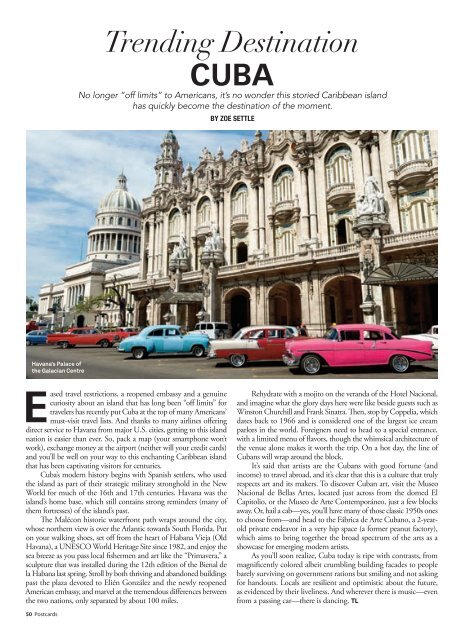Create successful ePaper yourself
Turn your PDF publications into a flip-book with our unique Google optimized e-Paper software.
Trending Destination<br />
CUBA<br />
No longer “off limits” to Americans, it’s no wonder this storied Caribbean isl<strong>and</strong><br />
has quickly become the destination of the moment.<br />
BY ZOE SETTLE<br />
Havana’s Palace of<br />
the Galacian Centre<br />
Eased travel restrictions, a reopened embassy <strong>and</strong> a genuine<br />
curiosity about an isl<strong>and</strong> that has long been “off limits” for<br />
travelers has recently put Cuba at the top of many Americans’<br />
must-visit travel lists. And thanks to many airlines offering<br />
direct service to Havana from major U.S. cities, getting to this isl<strong>and</strong><br />
nation is easier than ever. So, pack a map (your smartphone won’t<br />
work), exchange money at the airport (neither will your credit cards)<br />
<strong>and</strong> you’ll be well on your way to this enchanting Caribbean isl<strong>and</strong><br />
that has been captivating visitors for centuries.<br />
Cuba’s modern history begins with Spanish settlers, who used<br />
the isl<strong>and</strong> as part of their strategic military stronghold in the New<br />
World for much of the 16th <strong>and</strong> 17th centuries. Havana was the<br />
isl<strong>and</strong>’s home base, which still contains strong reminders (many of<br />
them fortresses) of the isl<strong>and</strong>’s past.<br />
<strong>The</strong> Malécon historic waterfront path wraps around the city,<br />
whose northern view is over the Atlantic towards South Florida. Put<br />
on your walking shoes, set off from the heart of Habana Vieja (Old<br />
Havana), a UNESCO World Heritage Site since 1982, <strong>and</strong> enjoy the<br />
sea breeze as you pass local fishermen <strong>and</strong> art like the “Primavera,” a<br />
sculpture that was installed during the 12th edition of the Bienal de<br />
la Habana last spring. Stroll by both thriving <strong>and</strong> ab<strong>and</strong>oned buildings<br />
past the plaza devoted to Elién González <strong>and</strong> the newly reopened<br />
American embassy, <strong>and</strong> marvel at the tremendous differences between<br />
the two nations, only separated by about 100 miles.<br />
Rehydrate with a mojito on the ver<strong>and</strong>a of the Hotel Nacional,<br />
<strong>and</strong> imagine what the glory days here were like beside guests such as<br />
Winston Churchill <strong>and</strong> Frank Sinatra. <strong>The</strong>n, stop by Coppelia, which<br />
dates back to 1966 <strong>and</strong> is considered one of the largest ice cream<br />
parlors in the world. Foreigners need to head to a special entrance,<br />
with a limited menu of flavors, though the whimsical architecture of<br />
the venue alone makes it worth the trip. On a hot day, the line of<br />
Cubans will wrap around the block.<br />
It’s said that artists are the Cubans with good fortune (<strong>and</strong><br />
income) to travel abroad, <strong>and</strong> it’s clear that this is a culture that truly<br />
respects art <strong>and</strong> its makers. To discover Cuban art, visit the Museo<br />
Nacional de Bellas Artes, located just across from the domed El<br />
Capitolio, or the Museo de Arte Contemporáneo, just a few blocks<br />
away. Or, hail a cab—yes, you’ll have many of those classic 1950s ones<br />
to choose from—<strong>and</strong> head to the Fábrica de Arte Cubano, a 2-yearold<br />
private endeavor in a very hip space (a former peanut factory),<br />
which aims to bring together the broad spectrum of the arts as a<br />
showcase for emerging modern artists.<br />
As you’ll soon realize, Cuba today is ripe with contrasts, from<br />
magnificently colored albeit crumbling building facades to people<br />
barely surviving on government rations but smiling <strong>and</strong> not asking<br />
for h<strong>and</strong>outs. Locals are resilient <strong>and</strong> optimistic about the future,<br />
as evidenced by their liveliness. And wherever there is music—even<br />
from a passing car—there is dancing. TL<br />
50 Postcards


